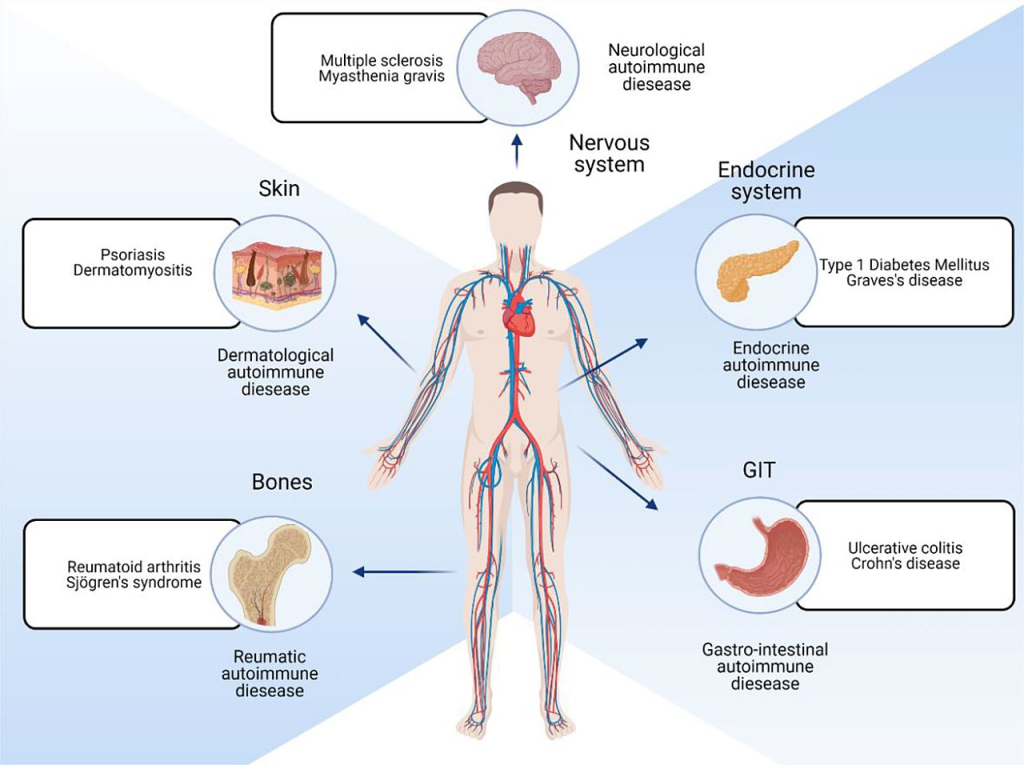Autoimmune diseases are diseases caused by an autoimmune response. The role of the human immune system is to protect the body from pathogenic microorganisms and cancer cells. When the immune system accidentally attacks your body instead of protecting it, it will cause damage or dysfunction of its own tissues and organs, resulting in autoimmune diseases. As for why the immune system does this, it’s unclear why.
Autoimmune diseases can involve any organ and affect people of any age. More than 100 autoimmune diseases have been discovered. Common autoimmune diseases include systemic lupus erythematosus, rheumatoid arthritis, inflammatory bowel disease, type I diabetes, etc. Patients with autoimmune diseases have autoantibodies against their own tissues, organs, cells and intracellular components, which are important signs in disease diagnosis. Each autoimmune disease is accompanied by a characteristic autoantibody spectrum.
Common Autoimmune Diseases
Autoimmune diseases caused by type II hypersensitivity: autoimmune hemolytic anemia, immune thrombocytopenic purpura, myasthenia gravis, toxic diffuse goiter, anti-glomerular basement membrane nephritis, anti-tubular basement membrane Nephritis etc.
Autoimmune diseases caused by autoantibodies-immune complexes: systemic lupus erythematosus, rheumatoid arthritis, Sjogren’s syndrome, polymyositis, dermatomyositis, scleroderma, etc.
Autoimmune diseases caused by T cell responses to self-antigens: type I diabetes, multiple sclerosis, etc.
Autoantibody Testing
Antinuclear Antibodies
Antinuclear antibodies (ANA) are a general term for a group of autoantibodies that use various nuclear components of one’s own eukaryotic cells as target antigens. The nature of ANA is mainly IgG, but also includes IgM, IgA and IgD. So far, more than twenty kinds of antinuclear antibodies against different components of the nucleus have been discovered. ANA mainly exists in serum, but can also exist in pleural effusion, joint synovial fluid and urine. Currently, indirect immunofluorescence (IIF) is most commonly used as the ANA screening test.
Anti-ENA Antibody Profile
ENA is the general term for extractable nuclear antigens. ENA antigens can be extracted from the nucleus with saline or phosphate buffer. Different autoimmune diseases produce different anti-ENA antibodies. Depending on the molecular weight and antigenic characteristics of the ENA antigen, different immune methods can be used to detect these autoantibodies. Currently, the most commonly used methods are immunoblotting technology (IBT) and dot enzyme immunoassay technology (dot-ELISA). The anti-ENA antibody profile is a confirmatory test for laboratory diagnosis of autoimmune diseases.
Antineutrophil Cytoplasmic Antibodies
Antineutrophil cytoplasmic antibodies (ANCA) are a group of autoantibodies that target human neutrophil cytoplasmic components and are closely related to a variety of clinical small vessel inflammatory diseases. This group of antibodies can be expressed as IgG, IgM or IgA. It has been confirmed that this antibody is the serum signature antibody of systemic vasculitis and is of great significance for the diagnosis, classification and prognosis of vasculitis. Detection can be divided into two types: medium ANCA and specific ANCA detection. The IIF method is usually used to detect total ANCA, and the ELISA method is most commonly used to detect specific ANCA.
Antiphospholipid Antibodies
Antiphospholipid antibodies (APLA) are autoantibodies directed against a group of antigenic substances containing phospholipid structures. These antibodies include anticardiolipin antibodies, antiphosphatidic acid antibodies, and antiphosphatidylserine antibodies. This group of antibodies can be divided into IgG, IgM and IgA types, with the IgG type being the most common. Among them, anticardiolipin antibodies are the most representative, because they have the strongest specificity and are the most studied in relation to various diseases. For the detection of anticardiolipin antibodies, ELISA is the most commonly used method.
Rheumatoid Factor
Rheumatoid factor (RF) is an antibody against the antigenic determinant of the Fc fragment of human or animal IgG molecules. It is an autoantibody with denatured IgG as the target antigen. Common RF types include IgM, IgG, IgA and IgE, with IgG being the main type and the type measured by conventional methods. Detection methods include latex particle agglutination test, rate scattering nephelometric method, and ELISA method.
Anti-Keratin Antibodies
Anti-keratin antibodies (AKA), also known as anti-keratin antibodies (ASCA), are mainly common in patients with rheumatoid arthritis. Indirect immunofluorescence analysis is commonly used for detection.
Autoantibodies also include anti-cyclic citrullinated peptide antibodies, anti-smooth muscle antibodies, anti-mitochondrial antibodies, anti-acetylcholine receptors, anti-skeletal muscle antibodies, etc. Autoantibody detection has become an important laboratory indicator in clinical immune testing.
Although autoantibodies are valuable biomarkers for diagnosis and classification, there is often no clear link between the specificity of autoantibodies and the resulting immunopathology, especially when the autoantigen is widely expressed intracellularly. In organ-specific autoimmune diseases, the association between autoantibodies and histopathology is often more pronounced than in systemic autoimmune diseases. Although these associations are strong, the reasons for the association between certain autoantibodies and clinical manifestations are unclear.
Autoantigen Recognition
The diverse clinical manifestations of autoimmune diseases require exploration of autoreactivity, especially for conditions that are not yet understood. In these studies, the first step is to search for autoantigens to provide a framework to consider the role of B and/or T cell autoreactivity in disease pathogenesis.
The recognition of autoantibodies and autoantigens is closely intertwined, as the analysis of autoantibodies relies on the recognition of the target antigen. Currently, screening of autoantigens is accomplished via large protein arrays, peptide arrays, or phage display libraries for target identification of antibodies in patient serum, using tissue extracts as the antigen source. These techniques allow screening thousands of proteins or peptide fragments for autoantigenicity and can complement traditional immunochemical techniques.
Autoantibodies with the same specificity can be expressed in different diseases. For example, antibodies against the protein glutamate decarboxylase (GAD) can occur in stiff-person syndrome as well as type 1 diabetes (insulin-dependent diabetes mellitus or IDDM). In this case, differences in the specificity of the autoantibodies for the antigen or their quantity may lead to different clinical manifestations.

